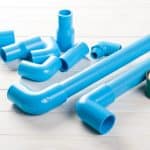Not just any container will do when it comes to food storage. If you’re hoping to store your food in a PVC container, you may need to think twice.
Regular PVC contains BPA, a chemical found to cause diabetes, infertility, high blood pressure, and more. Another harmful chemical found in PVC is phthalates. The FDA has suggested that containers for storing food be free of both BPA and phthalates. UPVC, also called rigid PVC, has neither chemical.
If you’re picky about the food you serve your family, you should be picky about the type of containers you put it in too.
Even though you don’t eat the container, the food stored in the container can absorb harmful chemicals in the packaging.
If you’re going to store your food in any type of PVC container, there are several things you should know, so keep reading to find out more about what makes a container food safe.

PVC vs.uPVC: Which Is Safe For food?
As you read above, standard PVC contains two harmful chemicals: BPA and phthalates. But how harmful are these chemicals?
BPA, formerly known as bisphenol A, is a chemical used for making hard plastic containers. In 2010, the FDA asked producers to stop using the chemical for containers for use with baby products (ie. formula, bottles, etc.).
According to WebMD, this change prompted producers to stop using the material in products for adults as well. So, what sponsored this change?
After a series of health studies conducted on mice, it was found that BPA could cause diabetes, infertility, and several other health risks.
These findings caused quite a bit of concern for the consumers.
While it would take a significant amount of BPA exposure to cause these negative health effects, why risk it? It is better to be safe than sorry and avoid eating or drinking out of a container that contains BPA.
So what about phthalates? Phthalates aren’t that healthy for you.
This chemical has been found to negatively affect our health in a variety of ways, including asthma, ADHD, and diabetes. Phthalates have also been found to impact fertility.
Phthalates are used to make plastic containers more flexible. That Tupperware container you store your lunch in every day probably contains phthalates, or something similar.
Taking these two chemicals into consideration, regular PVC clearly isn’t a safe option for food or drink. But aren’t some water pipes made from PVC? Yes, yes they are.
Luckily, these pipes are approved by the National Sanitation Foundation for safe use with potable water, also known as drinking water.
So what about uPVC? What even is uPVC?
uPVC, also known as unplasticized polyvinyl chloride, is primarily used for window frames and plumbing.
This material contains neither BPA nor phthalates, making it both food and water safe. This plastic material is even recyclable!
uPVC is often used as a replacement for wood. Additionally, uPVC is generally the type of material used for plumbing in your home. uPVC is also more durable than regular PVC.
Although uPVC is such an incredible material, it costs more to produce and is therefore not used to make many food-safe containers.
How to Tell if A Plastic Container Is Food Safe?
There are hundreds of different food storage containers available. However, not all of them are actually food-safe.
With society’s shift towards online shopping, it is increasingly easier to purchase products from other countries. These countries do not have the same restrictions as the United States.
In other words, you could be purchasing food storage containers that use BPA and phthalates.
Take Ziploc bags for example.
This is perhaps the most flexible plastic food container in production. For this reason, you’d assume that these individual bags contain lots of phthalates.
According to Ziploc’s website, their products are BPA, dioxin, and phthalate-free!
So what about other food containers? Luckily, there are several markings that tell you whether the container is considered food-safe or not.
The first method for identifying a food-safe product is looking at the recycling number.
This number is normally used to identify which plastic materials can be recycled at the plant, but you can use it to identify food-safe material.
This number is located inside a triangle shape. Recycling numbers 1-7 are considered safe for use with food.
The next symbol you can look for is a fork and a glass.
This symbol is used internationally to label containers considered food safe. You might not see this symbol on the container itself. Inspect the packaging the container comes in for the food-safe symbol.
The Safest Plastic Food Storage Containers
Finding plastic food storage containers can be difficult.
With so many different chemicals being used, it’s hard to know which containers will keep your food fresh without harming you and your family. Below are three of the safest plastic food storage containers you can use for every food storage.
Rubbermaid Vented Lids Food Containers
Rubbermaid is one of the best food storage brands in the country. As a well-known brand, you can trust that their products are safe to use with your food.
The Rubbermaid Vented Lids Food Containers are BPA and phthalates-free. Additionally, the vented lids make these the perfect containers to take to work. All you have to do is pop the food in the microwave and it’s ready to eat!
Ziplock Twist ‘n Loc Containers
As already mentioned, all Ziplock products are free from harmful chemicals such as BPA, dioxin, and phthalates. No matter what product you buy, you can rest assured that your food is being stored safely.
That said, the Ziplock Twist ‘n Loc containers are some of the best food storage containers out there. You can purchase them in a variety of different-sized containers to ensure you always have the right amount of space for your leftovers.
Additionally, the twist-to-seal tops make these containers the perfect leakproof container for both solid and liquid foods.
Rubbermaid Brilliance Storage
Storing your food isn’t just about being leakproof or working in the microwave, although that’s always nice. Sometimes you want a food storage container that looks good and works well! This is exactly what the Rubbermaid Brilliance Storage containers are.
These containers are BPA and phthalates-free. With these containers in your fridge, your food will store safely and look good in the meantime.





